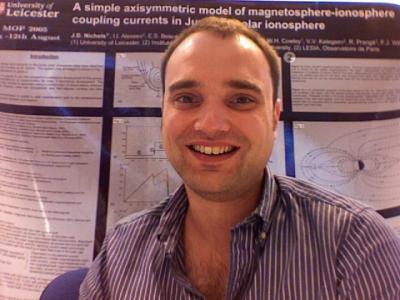University of Leicester planetary scientists have found new evidence suggesting auroras – similar to Earth's Aurora Borealis - occur on bodies outside our solar system.
Auroras occur on several planets within our solar system, and the brightest - on Jupiter – are 100 times brighter than those on Earth. However, no auroras have yet been observed beyond Neptune.
A new study led by University of Leicester lecturer Dr Jonathan Nichols has shown that processes strikingly similar to those which power Jupiter's auroras could be responsible for radio emissions detected from a number of objects outside our solar system.
In addition, the radio emissions are powerful enough to be detectable across interstellar distances – meaning that auroras could provide an effective way of observing new objects outside our solar system.
Auroras occur when charged particles in an object's magnetosphere collide with atoms in its upper atmosphere, causing them to glow. However, before hitting the atmosphere, these particles also emit radio waves into space.

This is Dr. Jonathan Nichols of the University of Leicester Department of Physics and Astronomy.
(Photo Credit: University of Leicester)
The study, Origin of Electron Cyclotron Maser Induced Radio Emissions at Ultracool Dwarfs: Magnetosphere-Ionosphere Coupling Currents, which recently appeared in the Astrophysical Journal, shows that this phenomenon is not limited to our solar system.
It shows that the radio emissions from a number of ultracool dwarfs may be caused in a very similar, but significantly more powerful, way to Jupiter's auroras.
Dr Nichols, a Lecturer and Research Fellow in the University of Leicester's Department of Physics and Astronomy, said: "We have recently shown that beefed-up versions of the auroral processes on Jupiter are able to account for the radio emissions observed from certain "ultracool dwarfs" - bodies which comprise the very lowest mass stars - and "brown dwarfs" - 'failed stars' which lie in between planets and stars in terms of mass.
"These results strongly suggest that auroras do occur on bodies outside our solar system, and the auroral radio emissions are powerful enough - one hundred thousand times brighter than Jupiter's - to be detectable across interstellar distances."
The paper, which also involved researchers at the Center for Space Physics, Boston University, USA, could have major implications for the detection of planets and objects outside our solar system which could not be discovered with other methods.
What's more, the radio emission could provide us with key information about the length of the planet's day, the strength of its magnetic field, how the planet interacts with its parent star and even whether it has any moons.
Dr Nichols added: "I am part of a group who have recently been awarded time on the Low Frequency Array (LOFAR) - centred in the Netherlands but with stations across a number of countries in northern Europe including the UK - to try to observe auroras on exoplanets, so hopefully there will be some interesting results soon."
Source: University of Leicester